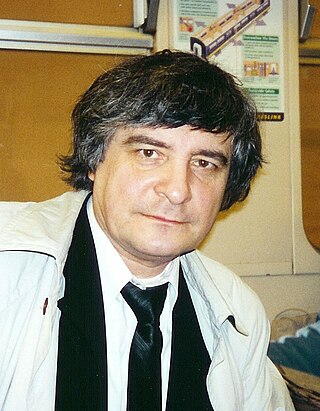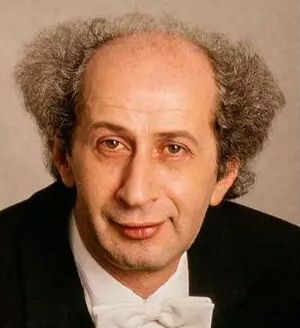Related Research Articles

Dmitri Dmitriyevich Shostakovich was a Soviet-era Russian composer and pianist who became internationally known after the premiere of his First Symphony in 1926 and thereafter was regarded as a major composer.
The Symphony No. 6 in B minor, Op. 54 by Dmitri Shostakovich was written in 1939, and first performed in Leningrad on November 5, 1939 by the Leningrad Philharmonic Orchestra under Yevgeny Mravinsky.

The Symphony No. 13 in B-flat minor, Op. 113 for bass soloist, bass chorus, and large orchestra was composed by Dmitri Shostakovich in 1962. It consists of five movements, each a setting of a Yevgeny Yevtushenko poem that describes aspects of Soviet history and life. Although the symphony is commonly referred to by the nickname Babi Yar, no such subtitle is designated in Shostakovich's manuscript score.

Rodion Konstantinovich Shchedrin is a Soviet and Russian composer and pianist, winner of USSR State Prize (1972), the Lenin Prize (1984), and the State Prize of the Russian Federation (1992), and is a former member of the Inter-regional Deputies Group (1989–1991). He is also a citizen of Lithuania and Spain.

Galina Ivanovna Ustvolskaya was a Russian composer of classical music.

The Symphony No. 2 in E minor, Op. 27, is a four-movement composition for orchestra written from October 1906 to April 1907 by the Russian composer Sergei Rachmaninoff. The premiere was performed at the Mariinsky Theatre in Saint Petersburg on 26 January 1908, with the composer conducting. Its duration is approximately 60 minutes when performed uncut; cut performances can be as short as 35 minutes. The score is dedicated to Sergei Taneyev, a Russian composer, teacher, theorist, author, and pupil of Pyotr Ilyich Tchaikovsky. The piece remains one of the composer's most popular and best known compositions.
Boris Alexandrovich Tchaikovsky, PAU, was a Soviet and Russian composer, born in Moscow, whose oeuvre includes orchestral works, chamber music and film music. He is considered as part of the second generation of Russian composers, following in the steps of Pyotr Tchaikovsky and especially Mussorgsky.

Alexander Grigori Arutiunian, also known as Arutunian, Arutyunyan, Arutjunjan, Harutyunian or Harutiunian, was a Soviet and Armenian composer and pianist, widely known for his 1950 Trumpet Concerto. A professor at Yerevan State Conservatory, he was recognized with many awards for his work, including the Stalin Prize in 1949 and People's Artist of the USSR in 1970, as well as numerous honors from his homeland of Armenia.
The Symphony No. 2 by Russian composer Galina Ustvolskaya was composed in 1979 and published in 1982. It received its premiere on 8 October 1980 in Leningrad with the Leningrad Philharmonic Orchestra conducted by Vladimir Altschuler.
The Symphony No. 3 by Russian composer Galina Ustvolskaya was composed in 1983, and published in 1990.

Dmitri Nikolaevich Smirnov was a Russian-British composer and academic teacher, who also published as Dmitri N. Smirnov and D. Smirnov-Sadovsky. He wrote operas, symphonies, string quartets and other chamber music, and vocal music from song to oratorio. Many of his works were inspired by the art of William Blake.

Gavriil Nikolayevich Popov was a Soviet composer.

The Canterville Ghost is an opera by the Russian composer Alexander Knaifel in three acts for 18 singers and chamber orchestra, also in an abridged version for two soloists and chamber orchestra.
Viktor Yevseyevich Suslin was a Russian composer. An associate of Sofia Gubaidulina's, together with her and Vyacheslav Artyomov he formed the improvisatory ensemble 'Astraea' in 1975. He emigrated to Germany in 1981.
Boris Ivanovich Tishchenko was a Russian and Soviet composer and pianist.

Vasily Eduardovich Petrenko is a Russian-British conductor. He is currently chief conductor of the European Union Youth Orchestra and music director of the Royal Philharmonic Orchestra.

Luonnotar, Op. 70, is a single-movement tone poem for soprano and orchestra written in 1913 by the Finnish composer Jean Sibelius. The piece is a setting of Runo I of the Kalevala, Finland's national epic, which tells the legend of how the goddess Luonnotar created the Earth. Luonnotar premiered on 10 September 1913 at the Three Choirs Festival in Gloucester, England, with Herbert Brewer conducting the festival orchestra; the soloist was the Finnish operatic diva Aino Ackté, the tone poem's dedicatee. A few months later on 12 January 1914, Ackté gave Luonnotar its Finnish premiere, with Georg Schnéevoigt conducting the Helsinki Philharmonic Orchestra.

Anatol Ugorski was a Russian-born German classical pianist and academic teacher. He studied at the Leningrad Conservatory, and played works by controversial Western composers such as Schoenberg, Alban Berg, Olivier Messiaen and Pierre Boulez rather than the usual repertoire for Russian pianists. An incident at a concert of Boulez in 1968 made Soviet authorities doubt his political reliability, and they largely interrupted his career for more than ten years. In 1982, he became professor at the Conservatory. When his daughter suffered antisemitic harassment in 1990, the family fled to East Berlin, where they lived in a refugee camp for several months. Irene Dische managed to arrange for him to record Beethoven's Diabelli Variations for Deutsche Grammophon in 1991, which launched a career of performing and recording. He became professor of the Hochschule für Musik Detmold, remaining in the post until 2007.
Russian composer Galina Ustvolskaya's Symphony No. 4 was composed between 1985 and 1987.
Symphony No. 5 by Russian composer Galina Ustvolskaya was composed between 1989 and 1990.
References
- ↑ "Catalogue of works, approved by G. Ustvolskaya". ustvolskaya.org. Retrieved 8 March 2019.
- ↑ Lemaire, Frans C. "GALINA USTVOLSKAYA - Piano Concerto, Symphony Nr 1". megadisc-classics.com. Retrieved 8 March 2019.
- ↑ Morrison, Simon. "Galina Ustvolskaya Outside, Inside, and Beyond Music History". academia.edu. p. 118. Retrieved 8 March 2019.